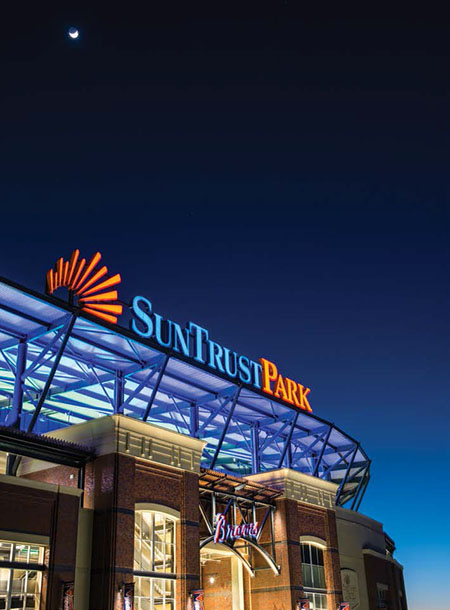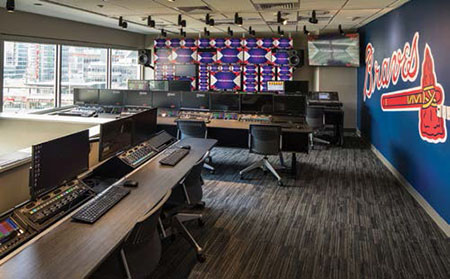‘BravesVision’ Comes to New Park
ATLANTA—The game’s the thing.

That may sound like a mere cliché, but Scott Cunningham, the Atlanta Braves’ senior director of fan experience, stands behind it. And to understand the video setup at SunTrust Park, the team’s new home field, the fans need to comprehend what he’s thinking.
While many franchises have installed video boards that are taller and wider than last year’s model as a new venue opens, that effect has left some observers wondering if their looming presence detracted from the game that was unfolding before them.
That led Cunningham to distance himself from that notion, and to ensure that the video element accentuated what was happening on the field—and didn’t take away from it.
That said, the Braves, Cunningham and Panasonic Enterprise Solutions are gunning for a high-tech video integration at SunTrust Park that will be hailed as the “best video show” in Major League Baseball.
BOARDS ABOUND
Cunningham has been with the Braves since 2005 (the year the big board at Turner Field, the Braves’ former home, was upgraded), and has had the benefit of going script-to-screen on the new installation, from the creative process to the issuing of the request for proposal, which was won by Panasonic; it’s now in its final stages of the initial install at SunTrust.
While the second board at Turner was, at one time, the largest LED board at a sports venue in the world (a fact that was certified by the “Guinness Book of World Records”), Cunningham now feels that the new main Panasonic board, dubbed “BravesVision”—while almost twice the size of what the Braves employed at Turner Field—suits today’s needs. But know that it’s not the largest screen in MLB.
The professional video industry's #1 source for news, trends and product and tech information. Sign up below.

The LED board at Atlanta’s new SunTrust Park may be bigger than the board at the Braves’ previous home, Turner Field, but it’s not the biggest in MLB—because the team didn’t want the video experience to overwhelm the fans as they also watch the action on the diamond. BravesVision and the rest of the LED boards at SunTrust are from Panasonic, with the featured setup displayed in dead centerfield. The 16mm pixel pitch display measures 64-feet by 120-feet, with a 16:9 aspect ratio and Surface Mount Display technology. Resolution is 2304x1224.
“[That resolution] used to be just for indoor boards,” Cunningham said. “Now, it’s for all 32 Panasonic boards in and around our ballpark, including the highway marquees and the plaza boards, aside from one—the Xfinity Rooftop Lounge—which is a 6mm board and needs the resolution because people can walk right up to it. So, it needs to be tighter. That’s also where we will team up with Georgia Tech [and others] to experiment with virtual reality at the park”
FROM THE SEATS
Inside the bowl, aside from BravesVision, other installs include the out-of-town scoreboard that measures 90-feet by 28-feet, which is situated in the leftfield power alley; and the 830-foot ribbon board that stretches from foul pole to foul pole (that will actually be segmented to include terrace level, but is still treated as one board). Lastly, the boards in the bullpens each measure 80-feet by 60 feet.
For Sports Fans, It’s Time to Shine
By Mark Smith
Imagine that you’re watching an Atlanta Braves game with your significant other at SunTrust Park—when, in a split second, you go from minding your bees’s wax to co-starring on the large-o-tron for Kiss Cam. Or maybe you’re grooving to the between-innings music and you wind up on Dance Cam. Or your spirit is so outrageous that you wind up the Fan of the Game.
Most people would like to freeze that memory with a pic, but have no way to be ready with their smartphones. However, thanks to New York-based 15 Seconds of Fame (15SOF), smartphone users can now reach a greater audience than just the other fans at the park; if they download the 15SOF app and take a selfie, after the game they can share their shining big board moment, in HD video, via social media. The hams in the stands will be glad to know that 15SOF, which has already been employed by a number of major sports franchises, recently announced a multi-year partnership with MLB Advanced Media (MLBAM) and the Big Ten Network that call for the company to employ its facial recognition technology to deliver personal video content to fans via the 15SOF app. The deal also gives 15SOF the rights to sell sponsorships for the content it distributes. “Our proprietary technology,” which uses unique algorithms to ingest, sort, clip and deliver crowd video and images from any type of camera feed, “will not only deliver the ultimate takeaway from a game experience for fans, but also offer an unprecedented opportunity for all live event and broadcast licensors, and sponsors, to connect with consumers,” said 15SOF CEO Brett Joshpe. The technology has “a hardware component, a software component and a cloud-based component,” Joshpe said. “Fans sign up for the app, either before or after they’re on camera. They take a selfie at registration and our ‘secret sauce’ does the rest, delivering all content (including still images) right to the user’s account on their phone. We have built significant barriers to entry through our [research and development], and our acquisition and development of IP.” The partnership with MLBAM (representatives from MLBAM did not respond to requests for comment by press time) began with this year’s Opening Day. It will include game broadcasts from all 30 MLB ballparks, which will call for the processing of more than 5,000 MLB telecast feeds this season. Fans can download the free app via iTunes and Google Play, and can view highlights on the app and at www.15sof.com. So now, all of the fans who have tried to snap a shot of themselves on the big screen don’t have to worry about being a millisecond too late. “Our solution is a first-mover and totally unique,” said Joshpe. “No other platform can deliver this kind of dynamic, personal content to fans. We are not limited to sports, either. Any live event where capturing the moment is important to participants is ideal for our product.”
There are numerous other video accents in and around SunTrust Park, such as a couple of small boards, including one that will be used in rightfield in a Chick-fil-a ad. On the park’s exterior, a large baseball-shaped LED board is hanging in the plaza; an 11-foot by 20-foot board above the Plaza stage in the park’s entertainment zone; and the iconic Braves’ script “A” (from the team’s caps) that is big enough for video, but may be used more for texture.
“There will be some experiments,” Cunningham said. “These are all new toys, so we’re excited to see what we have and what we can do with them.”
SCENE CAPTURE
The Grass Valley camera package at SunTrust Park features LDX 86 WorldCams, seven set to capture in-game action, 14 total. Five are grounded for crowd shots.
In this case, Cunningham is doing something different. “We’ll use the broadcast feed to garner content and replays, while we also anchor four cameras under BravesVision and one at high home, so the angles are straight from the middle of the field,” he said. “That allows me to get better angles of the crowd during fan shots.”
There are also two Wave Central wireless handhelds and three POV robotic cameras for the host positions: under BravesVision, under the bridge in the Plaza and in the press conference room, as well as four other Panasonic AK-HC5000 cameras in the Plaza for pregame festivities.
The control room houses a Ross Acuity 8ME switcher, “which is great for event production and game presentation, workflowwise,” Cunningham said. “It’s the best product of its kind on the market, and it allows control of several outputs.”
Video replay is courtesy of the Evertz DreamCatcher, with 12 channels in and two out with a Grass Valley routing switcher. “We went with hybrid and not full IP,” Cunningham said. CG is Ross Xpression, with eight channels, including five distributed to LED boards, which is of note “because there are various ways to drive BravesVision,” Cunningham said. “Ross is new at driving LED boards and was our choice, since they can do real-time rendering in 3-D.” The designer/controller is the Ross Xpression Tessera.
That setup, Cunningham said, enables the system integrator, Eden Prairie, Minn.-based Alpha Video, and the in-house crew “to do some cool stuff on BravesVision between pitches, like reveal new stats.”
ENCOMPASSING APPROACH
For Cunningham, creating the control room design is a career high point, especially when he considers the return on the Braves’ investment.
“I initially thought we’d need more money, but we made it work within our budget,” he said. “Everything we went after, we got. Our goal was to get the best equipment that we could afford; we got the latest and greatest, but still what would best complement our show. We think we do our game presentation better than any other professional sports team in the country.”
One key point about the SunTrust Park project, according to Jon Holvey, senior project manager for Panasonic—who has been working on-site with Cunningham—is how the adjacent entertainment district, complete with condos, a hotel, a winery and a taphouse, fits into the overall mixed-use project.

The control room at Atlanta Braves’ new SunTrust Park is anchored by a Ross Acuity 8ME switcher.
“That’s unique about this stadium,” said Holvey (who is also working on the install of a 68-foot by 28-foot Panasonic HD video board at Trustman Park, in Jackson, Miss., for a Braves’ minor league affiliate). “Usually, the stadium comes first, and other projects rise around it,” which explains the large number of video displays throughout the entire project, as well as interactive kiosks. “So, the Braves are using video throughout.”
Outside of the park, that means [using the video boards] to keep the fans entertained on game days, as well as off days, including the two double-sided billboards that stand adjacent I-75 and I-85, with everything controlled from the Braves’ control room.
“I think each new stadium adds more and more elements to what the previous new stadium offered,” Holvey said. “From a baseball standpoint, I think the Braves have done a good job offering an ample amount of video without being overwhelming.”
And that was the idea. Today, while the video team makes the last few tweaks before its “batter up” at the home opener, Cunningham is contemplating his new opportunities.
“This is the first time I had input into what equipment to buy,” Cunningham said. “It was a really rewarding experience.”
Mark R. Smith has covered the media industry for a variety of industry publications, with his articles for TV Technology often focusing on sports. He’s written numerous stories about all of the major U.S. sports leagues.
Based in the Baltimore-Washington area, the byline of Smith, who has also served as the long-time editor-in-chief for The Business Monthly, Columbia, Md., initially appeared in TV Technology and in another Futurenet publication, Mix, in the late ’90s. His work has also appeared in numerous other publications.

